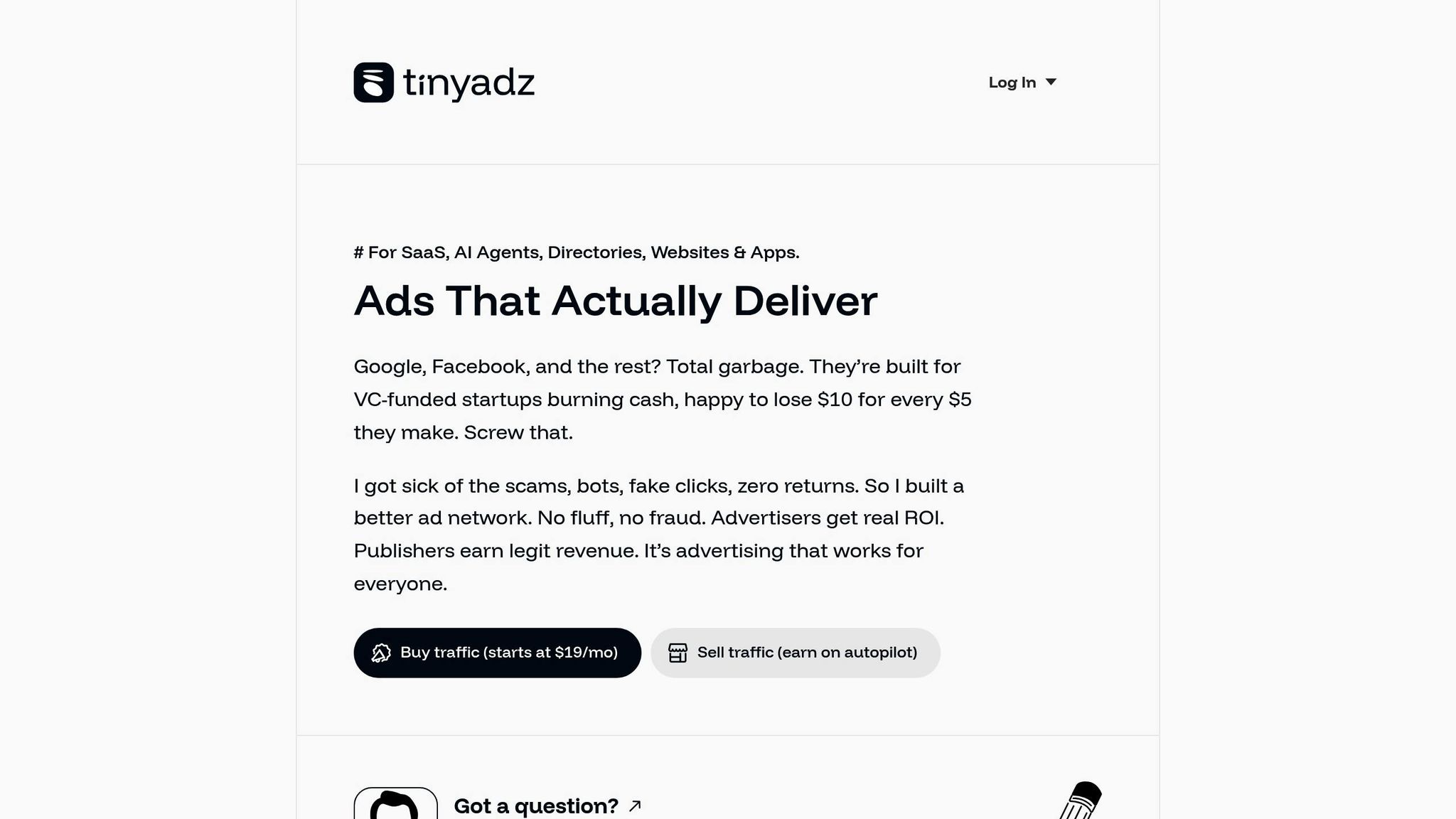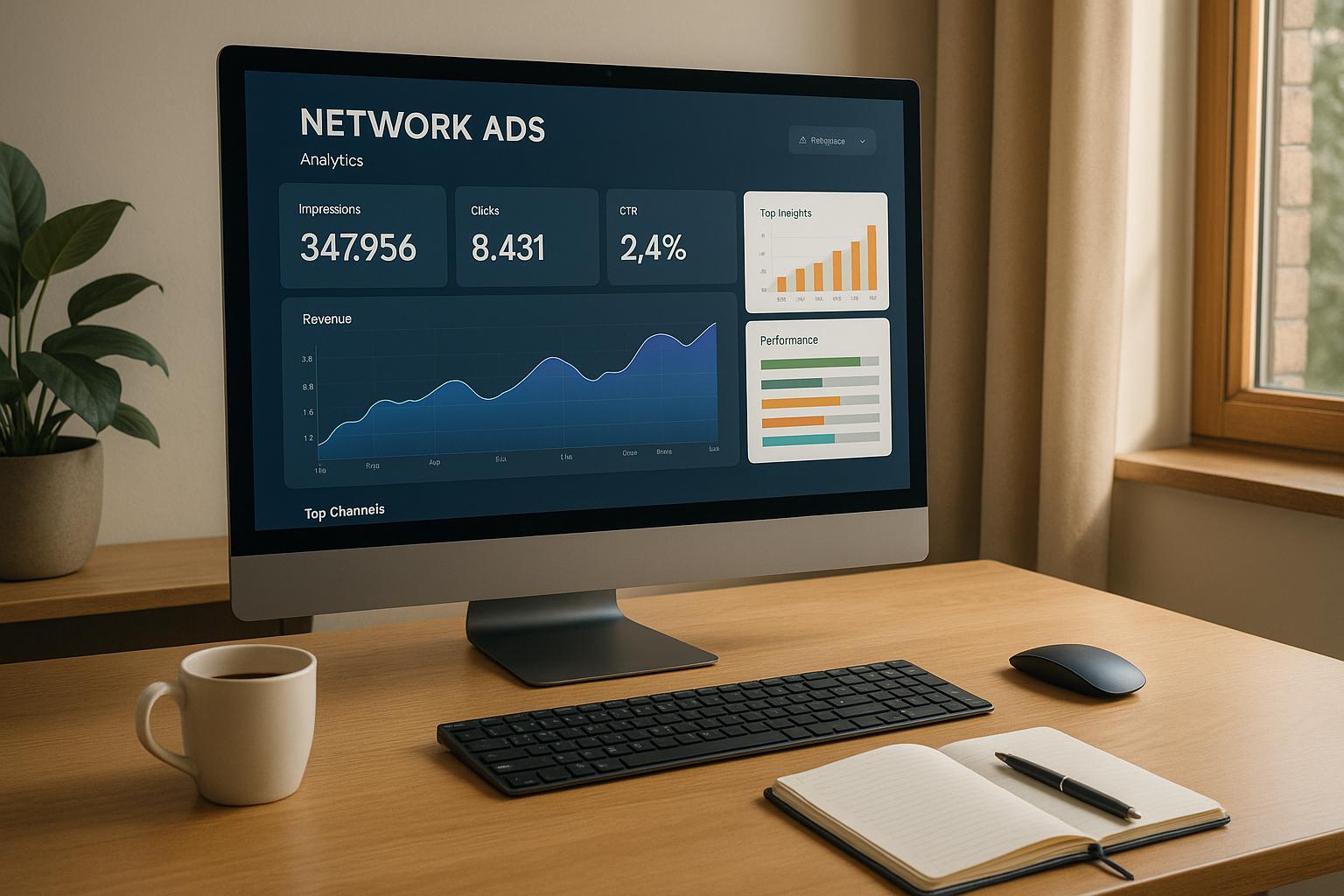Want to turn your website into a source of income? Here’s a quick guide:
- Display Ads: Use platforms like Google AdSense to show ads on your site. Place them strategically for better results.
- Affiliate Marketing: Earn commissions by promoting products or services that fit your site's niche.
- Sponsored Posts: Partner with brands to create content that aligns with your audience.
- Digital Products: Sell eBooks, courses, or templates directly to your visitors.
- Email Newsletters: Monetize with paid subscriptions, affiliate links, or sponsored content.
Pro Tip: Combine multiple strategies to diversify income and reduce risks.
The key is to match these methods with your audience and content style while maintaining a great user experience.
How to Monetize Your Website (10 Easy Ways!)
Main Ways to Make Money from Your Website
If you're looking to generate consistent income from your website while keeping your audience happy, there are several proven methods to explore. Each approach has its strengths, and combining a few can help diversify your revenue streams. Let’s break them down with practical tips to align with your audience’s needs.
Display Ads
One of the easiest ways to start earning from your website is through display ads. Research shows that 83% of users are open to seeing ads as long as they’re relevant and not intrusive. The trick lies in strategic placement and ensuring the ads resonate with your audience.
Platforms like Google AdSense simplify the process by automatically displaying ads tailored to your content and visitors. For niche publishers, tools like TinyAdz can help you serve ads that naturally blend with your site’s theme.
To maximize ad performance, consider these tips:
- Place ads where they feel natural, like within content or sidebars.
- Experiment with formats - video ads, for example, often get 2–3× higher click-through rates than static images.
- Keep loading times in check - 47% of users abandon pages that take longer than two seconds to load.
- Optimize for mobile, as 74% of users prefer returning to mobile-friendly sites.
Affiliate Marketing
Affiliate marketing is another popular way to earn, allowing you to make commissions by promoting products or services that fit your niche. In fact, affiliate marketing spending in the U.S. is projected to surpass $16 billion by 2028, with 81% of brands relying on it to attract new customers.
A great starting point is Amazon Associates, which offers commissions on a wide range of products. The key is to recommend products you genuinely believe in to maintain trust with your audience.
Here’s how to make affiliate marketing work for you:
- Use clear calls to action that encourage clicks.
- Test different link formats, like banners versus text links, to see what performs best.
- Be transparent about affiliate relationships to build credibility.
- Focus on products that solve specific problems for your audience.
Sponsored Posts and Brand Partnerships
Sponsored content is a growing revenue opportunity, with U.S. spending expected to exceed $10 billion by 2025. Plus, 70% of consumers prefer learning about products through content rather than traditional ads.
Authenticity is the cornerstone of successful sponsored posts. Partner with brands that align with your values and niche to keep your content genuine and engaging.
Tips for successful partnerships:
- Always disclose sponsored posts to maintain audience trust.
- Provide value in your content - don’t just push products.
- Use storytelling to make sponsored posts feel more natural.
Remember, one high-quality sponsored post can outperform multiple generic ones.
Digital Products and Services
Selling digital products is one of the most profitable ways to monetize your site. With no inventory limits and no shipping hassles, digital products can be sold globally with ease.
The opportunities are vast. For instance, the online education market is valued at $120.70 billion, and the personal development industry reached $43.77 billion in 2022, with steady growth projected.
Here are some real-world success stories:
- In 2021, Millie Adrian earned $400,000 by enrolling 600 students in her social media influencer courses, priced at $1,597 each.
- Lauren Taylor has generated multiple six-figure revenues since 2020 by offering permanent makeup artist courses to over 2,000 students.
Popular digital products include:
- Online courses and educational content – The e-learning market could hit $848 billion by 2030.
- eBooks and guides – Expected to grow to $22.76 billion by 2030.
- Membership sites and exclusive content – Many consultants earn over $8,000 monthly.
- Templates, tools, and digital downloads
"Almost anything can be turned into a membership site via HubSpot, Kajabi, Mighty Networks, or Circle. For budget-conscious buyers, you can even consider Squarespace."
- Liane Carrascoso, The Favorite Co.
Platforms like Patreon also offer creators a way to monetize through tiered memberships, providing everything from basic content access to premium perks.
Email Newsletter and Social Media Revenue
Your email list and social media platforms can also become valuable revenue streams. Email newsletters, for example, can earn through sponsored content, affiliate promotions, and paid subscription tiers. The key is to cultivate a list of engaged subscribers who value your insights.
Ways to monetize newsletters:
- Offer premium subscriptions with exclusive content.
- Include affiliate promotions that align with your audience’s interests.
- Sell sponsored spots to brands relevant to your niche.
- Promote your digital products directly to subscribers.
On social media, monetization works best as part of a larger strategy - use it to drive traffic back to your site, highlight affiliate products, and connect with potential sponsors.
As Jake Tripp of Launch Fulfillment explains:
"People should recognize that building a profitable site takes time and ongoing effort."
With these strategies in hand, you can decide which ones best suit your audience and content goals.
Pick the Best Revenue Methods for Your Website
Choosing the right monetization strategies for your website starts with understanding your niche and audience. The goal is to select methods that fit your unique situation and maximize your revenue potential.
Study Your Audience and Website Traffic
Your website analytics can be a goldmine for identifying profitable opportunities. Dive into metrics like page views, bounce rate, average time on site, and user behavior flows to see what resonates most with your audience and where monetization efforts could thrive. These insights reveal not just what your visitors like, but also how they interact with your content.
Keep in mind, traffic quality often outweighs sheer numbers. A smaller group of engaged visitors can generate more revenue than thousands of casual browsers. High-quality traffic - whether organic, referral, or direct - plays a critical role in successful monetization. To refine your approach further, create detailed audience personas that outline demographics, buying habits, and online behaviors. Tools like A/B testing and heatmaps can help you optimize ad placements or other revenue-generating elements.
Once you’ve gathered these insights, the next step is to align revenue methods with your specific content.
Match Revenue Methods to Your Content
Your content type plays a big role in determining which monetization strategies will work best. Whether you’re running a blog, producing videos, or sharing music, your format influences the methods you should choose. For instance, a photography blog might focus on selling prints or offering workshops, while a personal finance website could lean on affiliate marketing and premium guides.
It’s essential to align your monetization strategies with your audience’s interests. Ads or paid features should feel like a natural part of your content, not disruptive. A great example of this is The New York Times, which gained 10.2 million digital subscribers by building a loyal audience through high-quality journalism. Similarly, fitness influencer Adriene Mishler has created a sustainable income stream with her paid membership platform, Find What Feels Good, offering exclusive yoga content and fostering a sense of community.
For highly engaged audiences, methods like subscriptions or donations can thrive. On the other hand, if engagement is lower, passive income streams like display ads might be a better fit. Keep experimenting with different approaches and ensure your monetization strategies align with your brand’s image to maintain trust and credibility.
The key to long-term success is integrating revenue methods in a way that adds value to your audience while supporting sustainable growth.
sbb-itb-957fd63
Tools and Platforms for Making Money from Websites
When it comes to monetizing your website, the tools you choose should align with your audience, content, and revenue goals. Below, we’ll take a closer look at TinyAdz and how it stacks up against other leading monetization platforms.
TinyAdz: Tailored Ad Solutions for Niche Publishers

TinyAdz is designed specifically for niche publishers who want targeted ways to generate revenue. It offers multiple ad formats, including banner ads, directory listings, social media promotions, newsletters, and even live events.
What sets TinyAdz apart? For starters, it guarantees 100% human impressions and uses personalized matchmaking for ad placements. The platform stands out by simplifying earnings reports - no overwhelming dashboards or complex metrics. TinyAdz also creates a more controlled, less cluttered advertising space, which is particularly appealing for brands looking for safer placements. This is especially important considering that studies show only about one-third of every programmatic ad dollar actually reaches the publisher.
Another big advantage? TinyAdz has no minimum traffic requirements, making it accessible to publishers who are still growing their audience. This flexibility makes it a great option for smaller sites or those in niche markets. But how does it compare to other monetization platforms?
Comparing Leading Monetization Platforms
When evaluating monetization platforms, it’s essential to look at factors like revenue share, ad customization, targeting capabilities, and payment reliability. Some platforms, for example, offer revenue shares as high as 85% for display ads. Payment schedules also vary - some platforms pay weekly, while others stick to monthly cycles.
As mobile traffic continues to rise, it’s crucial to choose platforms that support mobile-responsive ad designs. Advanced targeting features, such as first- and third-party data integration, can significantly improve engagement. Seamless integration with your CMS and analytics tools is another must-have, along with API access and developer tools for automation and custom reporting.
To safeguard your earnings and reputation, prioritize platforms with features like real-time fraud detection, bot filtering, and ad verification. Many publishers find success by using a mix of platforms, which helps diversify revenue streams and reduces reliance on any single solution.
Lastly, focus on platforms that offer transparent reporting and dependable customer support. This ensures you have a clear understanding of your earnings and the factors affecting your performance, empowering you to make informed decisions as your website grows.
Increase Profits and Avoid Common Mistakes
Turning your website into a profitable venture requires careful planning and execution. To maximize your earnings and avoid common missteps, consider the following strategies. These practices can help you refine your approach and boost revenue effectively.
Use Multiple Revenue Sources
Relying on a single income stream can be risky. Diversifying your revenue sources is a smarter way to ensure stability and growth. By integrating a mix of monetization methods that suit your brand and audience, you can reduce dependency on one channel and tap into new opportunities.
Start by identifying what works well with your existing content and audience. For instance, if your site performs well with affiliate marketing, consider experimenting with ad placements or digital product sales. Test new strategies incrementally and evaluate their performance before fully committing.
Track Performance and Make Regular Updates
To improve your website’s profitability, you need to measure its performance. Analytics tools are essential for tracking key metrics like traffic, engagement, conversions, and site speed. These insights will guide your decisions and help you refine your strategies.
Google Analytics, used by millions of websites, remains a go-to tool. Its latest version, Google Analytics 4 (GA4), offers advanced features like real-time reporting, user acquisition insights, and monetization analysis. Focus on metrics that align with your goals. For example:
- If ad revenue is your priority, monitor page views, session duration, and bounce rates.
- For affiliate marketing, track click-through and conversion rates.
Remember, even small delays can hurt your bottom line - a one-second increase in load time could cost you 7% of your visitors. Regularly review your site’s performance and make improvements as needed.
| Metric | Description | How to Improve |
|---|---|---|
| Conversion Rate | Percentage of visitors completing a desired action | Conduct A/B testing, gather user feedback |
| Bounce Rate | Visitors leaving after viewing just one page | Speed up load times, provide relevant content |
| Average Session Duration | Time spent on your site | Offer engaging content, simplify navigation |
Follow Legal and Tax Rules
Monetizing your website comes with legal and tax obligations. Missteps - like underpaying taxes, filing late, or mixing personal and business expenses - can lead to costly penalties.
“Non-compliance exposes your business to penalties.”
For instance, if you expect to owe $1,000 or more in taxes, you’re required to make estimated payments. E-commerce businesses face additional challenges with sales tax. In 2023, there were over 11,000 sales tax rate updates and nearly 99,000 rule changes in the U.S. alone. Managing these complexities can be time-consuming and expensive. A small retail business might spend around 209 hours per month on tax compliance, costing roughly $24,000.
To avoid trouble, keep business and personal finances separate, maintain detailed records, and stay informed about changing tax laws.
Maintain a Seamless User Experience
Balancing revenue generation with a user-friendly experience is crucial for building loyalty and maintaining positive reviews. Overloading your site with intrusive ads or poorly implemented monetization strategies can backfire.
Take Splitwise, for example. When the app introduced a limit of three transactions per day and required users to watch a 10-second ad for each action, its Play Store rating plummeted from 4.7 to 1.9, accompanied by a flood of negative reviews.
To avoid similar pitfalls, gather regular feedback from your audience. Transparency is key - clearly disclose when content is sponsored or contains affiliate links. Personalizing monetization efforts, like showing targeted ads or recommendations, can make the experience feel less intrusive and even improve conversion rates.
“It’s not uncommon to see a lot of product teams think about pricing as one of the very last steps in the checklist to get a feature launch, as opposed to one of the very first steps.”
Conclusion: Build a Long-Term Website Revenue Plan
Creating a steady and reliable revenue stream from your website is not about chasing quick wins - it’s about laying down a foundation for long-term growth through thoughtful planning and consistent effort. The strategies outlined in this guide are most effective when viewed as part of a broader, ongoing plan rather than isolated tactics.
Diversification is the cornerstone of success. Depending on just one income source can leave you vulnerable to market shifts or platform changes. Instead, aim to balance your revenue streams - whether it’s through display ads, affiliate marketing, selling digital products, or offering sponsored content. A diversified approach helps ensure steady growth and reduces risks.
Your audience should always be at the center of your decisions. Tailor your monetization strategies to their preferences, ensuring trust and loyalty. Even a modest 5% boost in customer retention can lead to profit increases of over 25%. Building trust with your audience sets the stage for tools and strategies that can simplify and amplify your revenue efforts.
TinyAdz offers a streamlined solution for ad revenue management. Designed for niche publishers, it focuses on high-quality traffic and audience-specific content. By May 2024, TinyAdz was already hosting 1,062 websites and generating over a million views, proving its scalability for publishers of all sizes.
The secret to long-term success lies in constant evaluation and adaptation. Markets shift, audience behaviors change, and new opportunities emerge. By tracking key metrics, experimenting with new methods, and staying updated on the latest trends, you can keep your strategies relevant and effective.
As Larry Bossidy wisely said:
"Execution is the ability to mesh strategy with reality, align people with goals, and achieve the promised results."
Ultimately, the potential for your website to generate income grows as you strengthen connections with your audience and refine your monetization strategies. By focusing on delivering value, aligning your revenue methods with your content, and maintaining a positive user experience, you can turn your website into a dependable source of income that supports your long-term ambitions. Stick with these strategies, and you’ll be well on your way to building a sustainable revenue engine.
FAQs
How do I choose the best way to make money from my website based on my niche and audience?
To figure out the best way to monetize your website, start by getting a clear picture of your niche and your audience's preferences. Think about the kind of content you produce and how your audience interacts with it. Some tried-and-true monetization options include:
- Affiliate marketing: Promote products or services that align with your audience's interests and earn a commission for every sale or lead generated.
- Ad placements: Use display ads or similar tools to earn income based on your website traffic.
- Sponsored content: Collaborate with brands for paid partnerships that fit your niche.
- Selling digital products: Offer things like e-books, online courses, or templates designed for your audience.
Take the time to study your audience's behavior and test different approaches to see what works best. The goal is to create revenue streams that match your audience's needs while keeping their experience enjoyable and uninterrupted.
How can I display ads on my website without affecting the user experience?
To show ads without disrupting the user experience, focus on native advertising formats like in-feed ads or sponsored content. These formats seamlessly integrate with your website’s design, making them less intrusive. Position ads in high-visibility areas that don’t interfere with navigation, and steer clear of formats like pop-ups or auto-play videos, which can annoy visitors.
It’s also important to keep ads relevant to your audience and aligned with the context of your content. Strive for balance by limiting the number of ads on each page and experimenting with placements to see what drives the best results for both user engagement and revenue. This approach helps you monetize effectively while keeping your visitors happy.
How can I monitor and improve the performance of my website’s monetization strategies?
To keep tabs on your website’s monetization performance and make improvements, start by leveraging analytics tools such as Google Analytics. Focus on tracking essential metrics like click-through rates (CTR), bounce rates, and average session duration. These numbers give you a clear picture of how users interact with your site and how well your revenue strategies are working.
On top of that, pay attention to profitability metrics like return on ad spend (ROAS), revenue per thousand impressions (RPM), and earnings per thousand visitors (EPMV). Regularly reviewing these figures helps you pinpoint successful tactics and refine areas that aren’t meeting expectations.
Don’t forget that your website’s performance plays a major role in user engagement and revenue. Factors such as page load speed and overall user experience can make or break your monetization efforts. Use tools designed to measure site speed to ensure your visitors enjoy a smooth experience, boosting your potential earnings.


